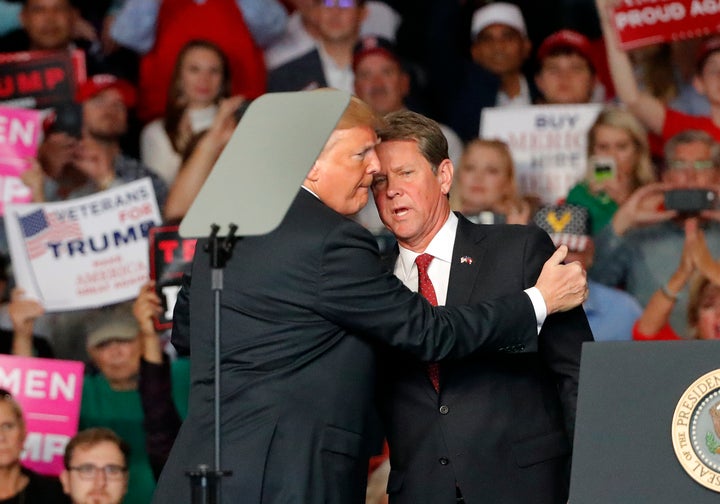The “caravan ad” from the Trump re-election campaign, which aired on NBC during “Sunday Night Football” after being rejected by CNN, is racist. It is blaringly, blatantly racist. It is designed to make white Americans scared of Latin American immigrants, to stoke fears of crimes committed by brown-skinned people and evoke existential demographic panic among a slice of the electorate that has been primed by years of similarly racist propaganda to fear a changing country.
Brian Kemp’s campaign for governor of Georgia is racist. He has abused his office as secretary of state to purge and otherwise block black Georgians from voting, and his campaign has been aided in the home stretch by a robocall in which someone posing as ”magical Negro Oprah Winfrey” delivers a bizarre racist monologue.

The Congressional Leadership Fund, a super PAC tied to outgoing House Speaker Paul Ryan (R-Wis.), has spent months airing dishonest ads slinging mud at various Democratic candidates. It has played a major role in the racist campaign against Antonio Delgado, the Democratic challenger to Rep. John Faso of New York’s 19th District. CLF’s ads refer in extremely unsubtly racist ways to the fact that Delgado once released a rap album.
The good news, such as it is, is that the mainstream, nonpartisan political press has been willing to call out these specific campaigns as racist, with no weasel words or qualifiers. CBS News called the pro-Kemp robocall racist. CNN called the caravan ad racist. Even The New York Times was willing to go as far as to say there were well-founded “suspicions” that the anti-Delgado campaign was ”motivated by racial bias,” which is about as plain-spoken as its news desk gets.
But these are still the exceptions. As the midterms hurtle to an astonishingly racist close, the nonpartisan political press has continued to rely on the old “racially tinged” euphemisms, taking care not to draw any conclusions about the party doing all the race-baiting. Call it denial-tinged journalism.
Last Friday’s print edition of The New York Times told us, “Trump Favorite Struggles to Rise in Florida After Racial Stumbles.” What a “racial stumble” might actually consist of is left to the reader to decode — I imagine the opening of “The Dick Van Dyke Show,” except Rob Petrie trips over a stack of Home Owners’ Loan Corporation redlining maps of Westchester County — though the web version helpfully updated the phrase to read ”racial flare-ups,” as if racism were conjunctivitis. In the story itself, we’re told Republican gubernatorial nominee Ron DeSantis has spoken at events organized and attended by “far-right extremists,” with a link to a September Washington Post story that tells us DeSantis “spoke at racially charged events.”
I do not believe, like Republicans who accused Barack Obama of being too soft on terror to say “radical Islam” or whatever, that speaking the correct words will magically make the enemy easier to defeat. But to beat back the rising tide of far-right ethnonationalism will require some sort of collective action on the part of people who are professionally unwilling to “take sides.” Fox News addicts are unreachable, but NPR listeners and local newspaper subscribers should be told an accurate version of the story of the moment.
This is that story: The only appeal the conservative movement has left is white panic. And they ― not just the demagogues like Donald Trump, but also the supposedly responsible wonks like Paul Ryan, and every shade of Republican in between ― are shameless and irresponsible enough to go to that well again and again, if it helps them maintain power. The caravan ad is the entire Republican midterm message, and they are actively restricting the electorate to exclude the people who wouldn’t fall for it. An entire political party stands united in its defense of the prevailing racial order, and its politicians are more than happy to say so in their campaigns. The racism isn’t some oafish slip-up; it’s the point.
What makes that story so difficult for the mainstream press to tell?
Part of it is a straightforward fear of being attacked by conservatives for perceived bias. As Tom Scocca wrote the other day: “The legacy media have been browbeaten into a perpetual terror of being seen as serving as partisans for the Democratic Party, until those are the only terms on which they understand the world and the work they’re doing.” To use plain language to accurately describe the actions of the entire Republican Party would make that party look so bad that it would be considered unfair and biased to have done so. And portions of the traditional press maintain the delusion that they can fight decades of conservative anti-press rhetoric by striving to be so “fair” to that side that they end up distorting what it believes and does.
Another reason is the special place accusations of “racism” hold in our elite discourse. In an industry still dominated by white men over 50, to be accused of racism is an injury on par with ― or perhaps worse than ― being actually targeted by racism. The stunted, elementary school-level way our old white editors and pundits think of race means that nothing can be described as “racist” without special knowledge of the inner mind of the person whose actions are clearly racist. It is a variation on the “we can’t call it a lie if we don’t know whether the liar knows he’s lying” rule, but even stupider. While the objective journalist can always reasonably fall back on calling things untrue without attributing motive, it requires a frontal lobotomy to render in the passive voice a mercenary campaign to make white Americans scared of a group of Central American refugees for political gain.
But another, possibly overlooked explanation for the utter inability of the press to describe the current moment is simply denial.
There are certain myths that are central to the ideology ― one that defines itself as a total lack of ideology ― of the nonpartisan journalist class. Some of those myths fall under a category that we could broadly call “American Exceptionalism.” It is, basically, a child’s faith that we live in the best of all possible countries.
One of those myths, universally believed by the Sunday-show types, is that America and its people are essentially Good. A corollary to this belief is that white rural Americans are the Realest Americans, and hence, the Goodest. This is not an original observation, but the Trump era, with the mask fully ripped off, has introduced a new wrinkle. This impoverished, limited worldview is now forced to grapple with these inescapable facts: One political party is running nakedly racist appeals to a solely white base ― with essentially no exculpatory side issues or cover story anymore ― and they are doing so because it works. At least, it works well enough to motivate a sufficient segment of the white population to show up for the Republicans to win power, so long as they currently have the power to suppress the votes of the demographic groups less amenable to far-right ethnonationalism.
So now the class that couldn’t fathom how anyone’s pastor could ever say the words “God damn America” attempts to explain a world whose rules violate that class’ core beliefs about the character of the American people, in the extremely limited way it has traditionally defined them. Pundit Americana requires the Realest Americans to be a people of rough-hewn racial innocence, perhaps reflecting the pundits’ own blamelessness.
These journalists have no choice but to make the campaign of hate and fear sound like an accident (who among us hasn’t suffered a “racial stumble”?), or a mistake, or something not so much willful as chemical (“racially charged,” they say). Partly it’s because they’re scared of cynical operators calling them unfair, but mostly it’s because they are, themselves, afraid of being fair.

